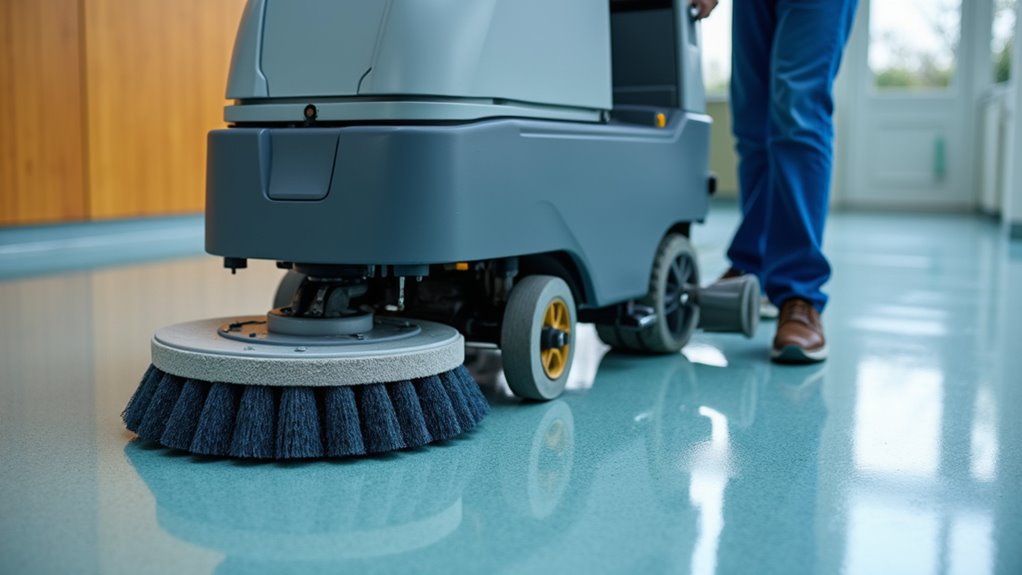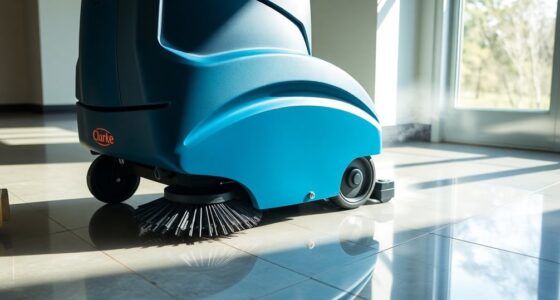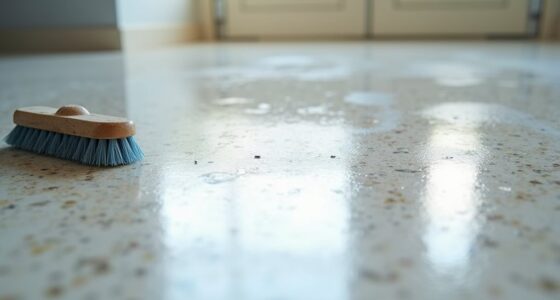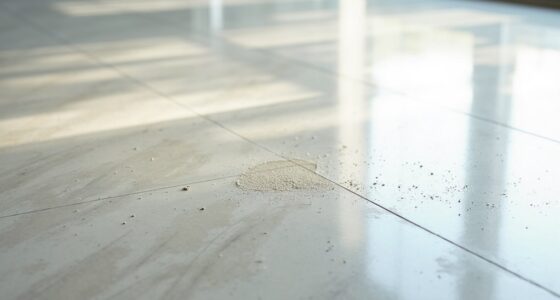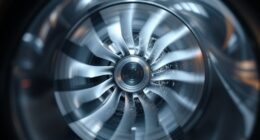When setting up your auto-scrubber for epoxy floors, choosing between a pad and a brush depends on your cleaning needs. Pads are softer and great for gentle polishing or light cleaning, while brushes are more aggressive for stubborn dirt. Attach your tool securely and adjust settings to match the surface. Using the right tool prevents damage and guarantees effective cleaning. Keep exploring for tips on optimizing your auto-scrubber setup and achieving perfect results.
Key Takeaways
- Use pads for gentle cleaning and polishing, ideal for epoxy surfaces with light dirt.
- Choose brushes for aggressive scrubbing of stubborn grime on epoxy floors.
- Securely attach the pad or brush, ensuring proper fit to prevent dislodging during operation.
- Adjust machine settings based on the tool type and cleaning intensity needed.
- Select the appropriate tool considering floor condition and debris type for effective cleaning.
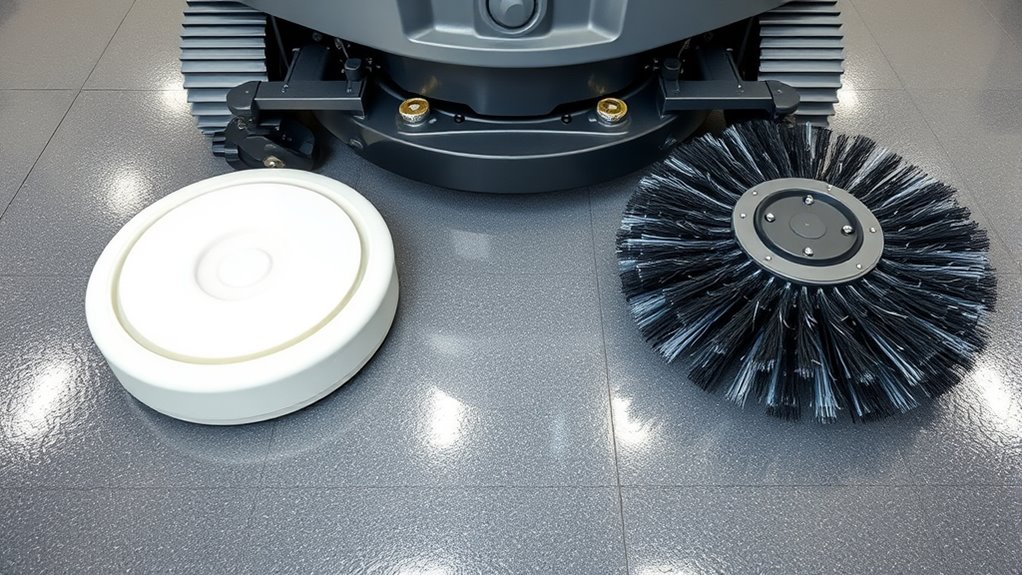
Setting up an auto-scrubber for floors is a straightforward process that guarantees efficient cleaning. To get started, you’ll want to ensure the machine is properly prepared, which includes selecting the right cleaning solution and maintaining the battery. Your choice of cleaning solution is crucial; it directly impacts cleaning effectiveness and the longevity of your equipment. Use a solution specifically formulated for epoxy floors to avoid damage or residue buildup. Measure and pour the cleaning solution into the designated tank, following the manufacturer’s instructions for dilution. Properly filling and mixing the solution guarantees optimal cleaning results without wasting resources or risking damage to the floor.
Next, focus on battery maintenance, a key factor for smooth operation. Before starting, check that the battery is fully charged. Most auto-scrubbers have indicators to show battery status—ensure it’s at full capacity to maximize cleaning time and prevent interruptions. Regularly inspecting and maintaining the battery prolongs its lifespan and ensures reliable performance. Keep terminals clean and free of corrosion, and follow the manufacturer’s guidelines for charging cycles. If you notice the battery isn’t holding a charge or the machine runs out of power sooner than expected, consider replacing or servicing the battery. Proper battery maintenance is essential for avoiding downtime and keeping your auto-scrubber ready for daily use.
Once your cleaning solution is prepared and the battery is in good shape, you can decide between using a pad or a brush for scrubbing. This choice hinges on your floor’s condition and the type of debris you need to remove. Pads are generally softer and ideal for gentle polishing or light cleaning, especially on epoxy surfaces that can be sensitive to scratches. Brushes, on the other hand, are more aggressive and suitable for scrubbing stubborn dirt or grime. When setting up, attach the chosen scrubbing tool securely to the machine, making sure it’s fitted correctly to avoid dislodging during operation. Adjust the machine’s settings according to the type of pad or brush you’re using, ensuring you’re not applying excessive pressure that could damage the epoxy floor. Additionally, understanding the contrast ratio of your cleaning equipment can help you gauge how well it will perform in different lighting conditions, ensuring a thorough clean every time.
Frequently Asked Questions
How Do I Maintain My Auto-Scrubber Long-Term?
To maintain your auto-scrubber long-term, follow regular maintenance routines like cleaning filters, checking brushes or pads, and inspecting for wear. Keep an eye on replacement schedules for parts like brushes, pads, and batteries to guarantee peak performance. Regularly schedule professional tune-ups, and store the equipment properly after each use. These steps will extend your machine’s lifespan and keep it running efficiently for years to come.
Can Auto-Scrubbers Be Used on Uneven Epoxy Surfaces?
Did you know that 65% of floors in industrial settings have some unevenness? Auto-scrubbers can be used on uneven epoxy surfaces, but surface adaptation is key. Choose machines with adjustable heads or flexible brushes to guarantee effective cleaning without damage. These features allow the scrubber to conform to uneven surfaces, providing thorough cleaning and preventing unnecessary wear on your equipment. Proper setup makes all the difference in maintaining epoxy floors.
What Safety Precautions Should I Follow During Setup?
During setup, you should prioritize electrical safety by inspecting cords and connections for damage and making certain proper grounding. Always wear personal protective equipment like gloves, goggles, and non-slip footwear to prevent injury. Keep the workspace dry to avoid electrical hazards, and follow the manufacturer’s instructions carefully. Double-check that all parts are securely attached before operation, and never bypass safety features to ensure a safe, effective cleaning process.
Are There Eco-Friendly Pad and Brush Options Available?
Yes, eco-friendly options are available for pads and brushes. You can choose products made from biodegradable materials that reduce environmental impact. Look for pads and brushes labeled as biodegradable or made from recycled, sustainable resources. These options help minimize waste and promote eco-conscious cleaning. By selecting eco-friendly pads and brushes, you contribute to environmental preservation while maintaining effective cleaning for your epoxy floors.
How Often Should I Replace Pads or Brushes for Optimal Results?
Ever wonder when your pads and brushes are no longer working their best? You should replace pads when their lifespan shows signs of wear, like tearing or loss of effectiveness, typically after 20-30 hours of use. For brushes, monitor for bent or frayed fibers, replacing them every 50-100 hours depending on usage. Regular checks guarantee peak cleaning and prolong equipment life, keeping your epoxy floors gleaming.
Conclusion
Choosing between a pad and a brush for your auto-scrubber is like selecting the right brush for a masterpiece—you want precision and control. Both options have their strengths, so consider your floor’s specific needs. With the right setup, you’ll navigate your epoxy floors like a skilled artist, leaving them spotless and gleaming. Remember, the right tool makes all the difference in turning a messy job into a smooth, effortless glide.
